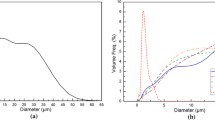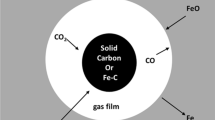Abstract
Silicon recovery of silica ore (\( {\text{SiO}}_{2} \)) has been studied with two types of carbon materials, charcoal as a biomass and coal as a fossil fuel, at elevated temperatures between 1800 and 2000°C in an electric arc furnace. The effects of porosity and electrical resistance of the carbon materials were investigated. To this end, recovery of silicon and ferrosilicon production were tested separately by charcoal and coal, and the products were investigated both qualitatively and quantitatively. A higher electrical resistance of charcoal was found in comparison with coal, with increased efficiency of the furnace and decreased electric energy consumption (per ton of product). The efficiency of the furnace using charcoal and coal was 92.13% and 77.4%, respectively. In addition, the higher porosity of charcoal facilitates the flow of SiO gas through the carbon material leading to a higher reactivity and reducing the electric energy consumption for each ton of FeSi.






Similar content being viewed by others
References
F. Li, M. Tangstad, and E. Ringdaneld, Metall. Mater. Trans. B 49, 1078 (2018). https://doi.org/10.1007/s11663-018-1195-x.
E. Ringdalen, JOM 67, 484 (2015). https://doi.org/10.1007/s11837-014-1149-y.
M. Gasik, Handbook of Ferro Alloys Theory and Technology, ed. M. Tangstad, (Massachusetts, Ma: Elsevier, 2013). p. 179.
G. Tranell, M. Andersson, E. Ringdalen, O. Ostrovski, and J.J. Steinmo, Reaction zone in a FeSi75 furnace-results from an industrial excavation, 12th international ferro alloys congress (Helsinky: Finland, 2010), pp. 709–716.
F. Buboltz Ferreira, B. Deves Flores, E. Osório, and A. Cezar Faria Vilela, REM. Int. Eng. J. 71, 411 (2018). https://doi.org/10.1590/0370-44672017710040.
Z. Chen, W. Ma, K. Wei, S. Li, and W. Ding, J. Clean. Prod. 158, 359 (2017). https://doi.org/10.1016/j.jclepro.2017.05.037.
H. Hasannezhad and A.H. Meysami, JOM 71, 336 (2019). https://doi.org/10.1007/s11837-018-3172-x.
M. Fraga, B. Flores, E. Osório, and A. Vilela, J. Mater. Res. Technol. 9, 3406 (2020). https://doi.org/10.1016/j.jmrt.2020.01.076.
R.G.D. Pinto, A.S. Szklo, and R. Rathmann, Energy Policy 114, 380 (2018). https://doi.org/10.1016/j.enpol.2017.11.040.
J.G. Pohlmann, A.G. Borrego, E. Osório, M.A. Diez, and A.C.F. Vilela, J. Clean. Prod. 129, 1 (2016). https://doi.org/10.1016/j.jclepro.2016.04.138.
T. Norgate, N. Haque, M. Somerville, and S. Jahanshahi, ISIJ 52, 1472 (2012). https://doi.org/10.2355/isijinternational.52.1472.
S. Halder and R.J. Fruehan, Metall. Mater. Trans. B 39B, 796 (2008). https://doi.org/10.1007/s11663-008-9203-1.
B. Monsen and B. Tangstad, Use Of Charcoal in Silicomanganese Production, Tenth International Ferroalloys Congress, Cape Town, South Africa, 1–4 February 2004, pp. 392–404.
Y. Liu and Y. Shen, Fuel 258, 116088 (2019). https://doi.org/10.1016/j.fuel.2019.116088.
M. Somerville and S. Jahanshahi, Renew. Energy 80, 471 (2015). https://doi.org/10.1016/j.renene.2015.02.013.
N.K. Batra, Ironmak. Steelmak. 30, 399 (2003). https://doi.org/10.1179/030192303225004088.
S. Tian-ming, D. Li-min, W. Chen, G. Wen-li, W. Li, and L. Tong-xiang, New Carbon Mater. 28, 349 (2004). https://doi.org/10.1016/S1872-5805(13)60087-6.
Zh. Nurmukhanbetov, O. Privalov, L. Prokopyev, Reducibility and Electric Resisntance of Carbonaceus Materials Within Ferroalloys Smelting Processes, in The 13th International Ferroalloys Congress, Almaty, Kazakhstan, June 9–13, 2013, 479-488.
K. Nishimiya, T. Hata, H. Kikuchi, and Y. Imamura, J. Wood. Sci. 50, 177 (2004). https://doi.org/10.1007/s10086-003-0532-z.
Acknowledgement
The authors are grateful to the Golpayegan Faculty of Engineering, Iran Ferroalloys Industries Co. and to Mr. Ali Nasiri for his assistance.
Author information
Authors and Affiliations
Corresponding author
Ethics declarations
Conflict of interest
On behalf of all the authors, the corresponding author states that there is no conflict of interest that could have appeared to influence the work reported in this paper.
Additional information
Publisher's Note
Springer Nature remains neutral with regard to jurisdictional claims in published maps and institutional affiliations.
Supplementary material
Below is the link to the electronic supplementary material.
Appendix: Calculation of Carbon Material Weight
Appendix: Calculation of Carbon Material Weight
In Eq. 5, \( {\text{X}} \), \( {\text{F}} \), \( {\text{W}}_{{{\text{SiO}}_{2} }} \), \( {\text{m}} \), and fix C are the carbon materials’ weight, weight ratio, quartz rock weight, moisture percentage, and carbon content, respectively.
The amount of \( {\text{Si}} \) in the quartz rock in the inlet to the furnace is calculated by Eq. 6:
In Eq. 6, \( {\text{Si}}_{\text{inlet}} \), \( {\text{W}}_{{{\text{SiO}}2}} \), \( {\text{M}}_{\text{Si}} \), \( {\text{M}}_{{{\text{SiO}}_{2} }} \), and \( P \) are the amount of \( {\text{Si}} \) in the quartz rock, quartz rock weight, \( {\text{Si}} \) molecular weight, \( {\text{SiO}}_{2} \) molecular weight, and quartz rock purification percentage, respectively. The value of \( {\text{Si}} \) in the melt outlet from the furnace is calculated by Eq. 7 as follows:
In Eq 7, \( {\text{Si}}_{\text{outlet}} \), \( {\text{W}}_{\text{melt}} \), and \( p^{\prime } \) are the values of \( {\text{Si}} \) in the melt outlet from the furnace, the melt weight, and the \( {\text{Si}} \) weight percentage in the melt, respectively. Finally, the efficiency of \( {\text{Si}} \) recovery (\( ef_{Si} \)), based on Eqs. 5–7, is calculated as Eq. 4:
Rights and permissions
About this article
Cite this article
Hasannezhad, H., Meysami, A. Comparison of Biomass and Coal in the Recovery Process of silicon in an Electric Arc Furnace. JOM 73, 1030–1036 (2021). https://doi.org/10.1007/s11837-020-04533-6
Received:
Accepted:
Published:
Issue Date:
DOI: https://doi.org/10.1007/s11837-020-04533-6




